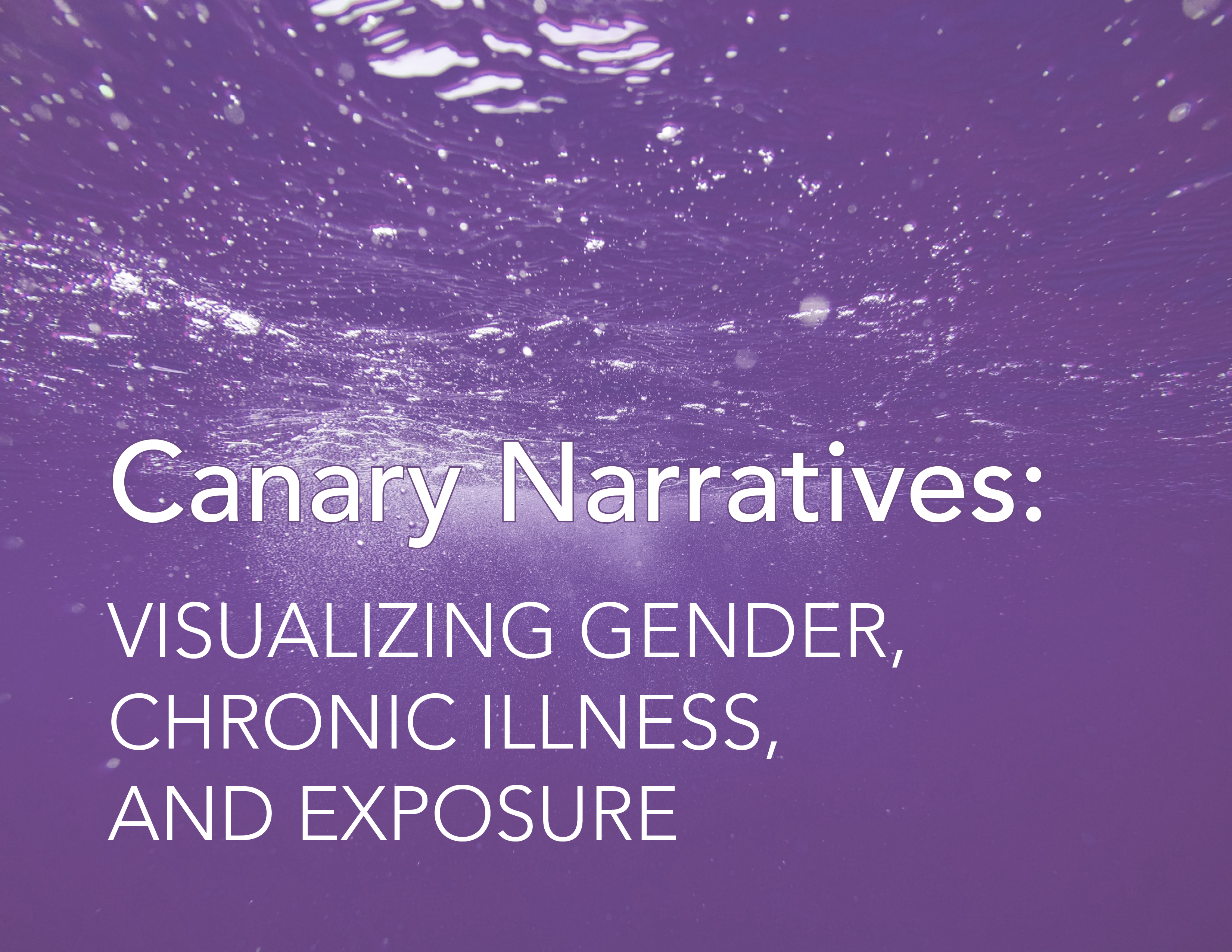
People with illnesses caused by toxic exposure are often referred to as canaries: like canaries in coal mines, they warn others of the mounting harm of everyday exposure to the toxic products of capitalism, from personal care products to industrial effluent. As part of the Chemical Entanglements initiative at the UCLA Center for the Study of Women (CSW), we are exploring how visual representations of canary narratives can serve as activist tools and challenge gendered conceptions of chronic illness as imagined or hysterical.
In collaboration with artist and poet Peggy Munson, CSW has produced a series of cartoon-like provocations designed to confront viewers with the violence and harm caused by toxic personal care products, particularly to women, people of color, LGBTQ individuals, and other already-vulnerable persons. Building on this work, we aim to produce imagery to accompany a forthcoming series of oral histories. These oral histories will document the lives of activists who work to expose the accumulating damage caused by toxicants, and in so doing, advocate for change at both individual and institutional levels. How, we ask, can visualizing their narratives underscore how toxic exposure is a gender equity issue? How might these visualizations work in concert with data visualizations to persuade policymakers to take action to protect the public health? In addition to creating new visualizations, we will collect and invite crowdsourced commentary on existing artistic representations of the symptoms of toxic exposure (from graphic novels, zines, films, etc.) created by chronically ill individuals. In so doing, we will ask what a feminist approach—one that is intersectional, which advocates without objectifying, which centers marginal perspectives--to visualizing canary narratives might look like.
References
Hyland, Tara. 1999. “Creative Meaning-Making: Reading the Bookworks of Lise Melhorn-Boe.” Journal of Artists' Books 11: 11-15.
International Programme on Chemical Safety. 2002. Global Assessment of the State-of-the-Science of Endocrine Disruptors. Geneva:World Health Organization. 2002. Accessed November 20, 2018: http://www.who.int/ipcs/publications/new_issues/endocrine_disruptors/en/
Johnston, Jill E., and Andrea Hricko.2017. “Industrial Lead Poisoning in Los Angeles: Anatomy of a Public Health Failure.” Environmental Justice 10 (5): 162-167. http://doi.org/10.1089/env.2017.0019
Miller, Claudia S.1997. “Toxicant-induced loss of tolerance--an emerging theory of disease?” Environmental Health Perspectives,105 (Suppl 2), 445–453.
Porter, Catherine A., et al. 2009. Overexposed and Underinformed: Dismantling Barriers to Health and Safety in California Nail Salons. Healthy Nail Salon Collaborative. Accessed November 20, 2018: https://static1.squarespace.com/static/5783e9b9be6594e480435ffe/t/58f449...
Zwillinger, Rhonda. 1998. The dispossessed: living with multiple chemical sensitivities. Paulden, AZ: Dispossessed Project.
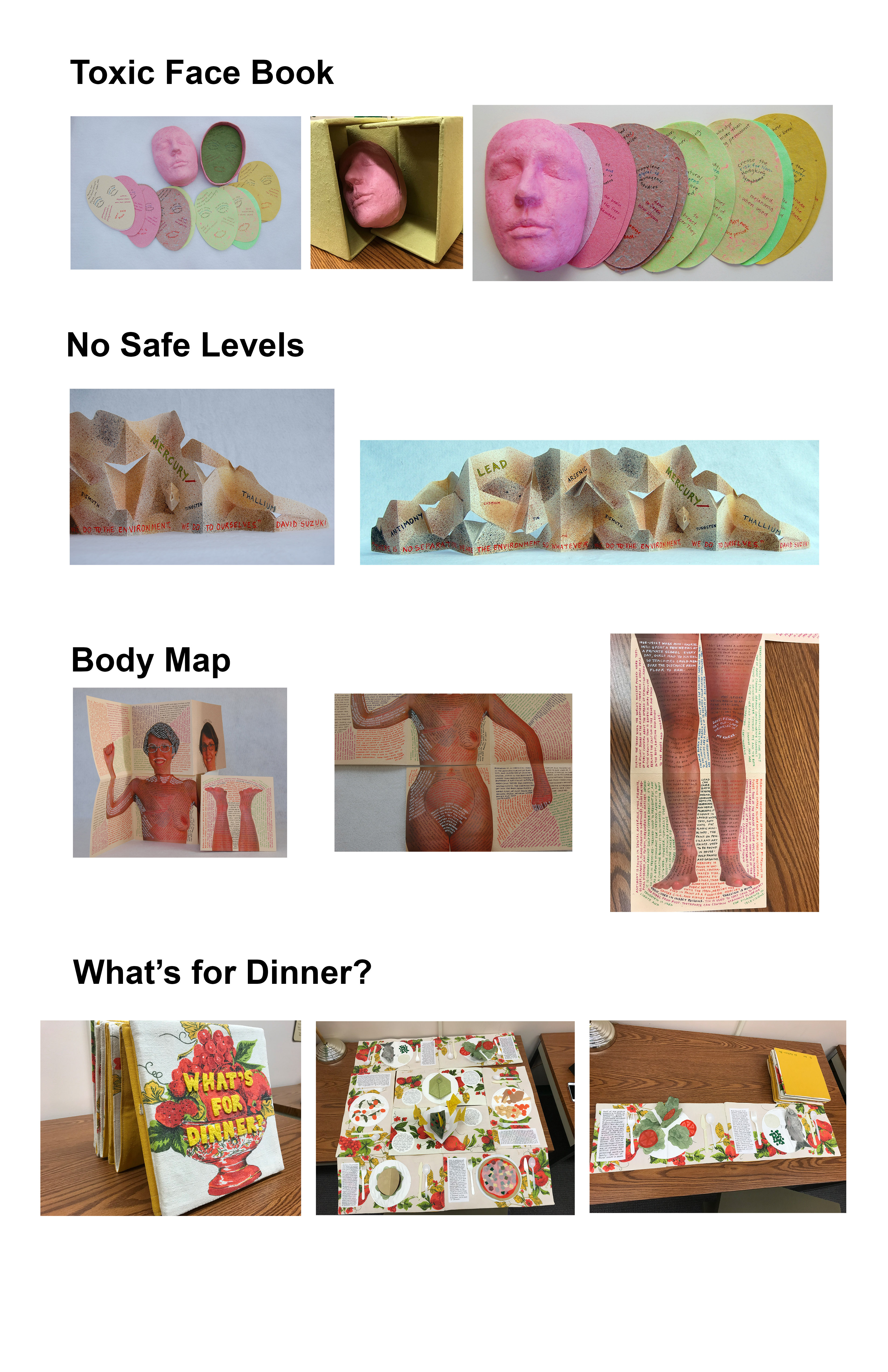
Substantive Caption:
The early works of Canadian artist Lise Melhorn-Boe inquired into the thwarted, deferred, and transferred artistic desires of women. In Color Me Dutiful (1986), Melhorn-Boe collected stories elicited from women as to why they wear make-up, printing those desires and recollections on oval paper leaflets (i.e., faces) collected in a receptacle whose cover is a plaster cast of her own mienne. After becoming ill with breast cancer and, then, felled by exposure to mold, Melhorn-Boe returned to the oval leaflets with a new awareness of environmental toxins that had likely contributed to her own health. Toxic Face Book (2008) returns to the landscape of the face and lists the chemical ingredients of the many emollients and hues that women use regularly. The artist’s life history of exposures to heavy metals are also rendered via a pop-up book, No Safe Levels (2006), figuring a topography of rolling hills and peaks, the overall shape based on her body’s profile while lying sideways and inscribed with the heavy metals that turned up in her laboratory panel. In What’s for Dinner (2011), a textual homage and spin on Judy Chicago’s The Dinner Party, she prompts the picnic goer to unfold a series of meals that list the contaminants in food that contribute to total body burden. The large (40 inch) fold-out work, Body Map (2009), features a photograph of the artist’s post-mastectomy figure, with a personal and public environmental history inscribed across various body parts.
Design Statement:
We selected this visualization because:
Melhorn-Boe’s “thick description” art, detailing encounters with toxicity, has been less quick to sell than earlier work. Though her table-top treasure boxes, origami-ed landscapes, and pop-up book/ quilt mashups cry out to be touched, they also record how we are contaminated and in constant contact with EDCs. The art provides an ethnographic encounter, making tactile the invisible chemicals that surround us. However, the lay public wishes to keep the knowledge about the risks of living in (post)industrial ecologies at a distance.
The visual art represents something soft that might offer solace against the ominous lists of chemicals/EDCs. Melhorn-Boe sews and folds stories of living in non-purity, in contaminated and disabled canary being into missives of tactile communion.
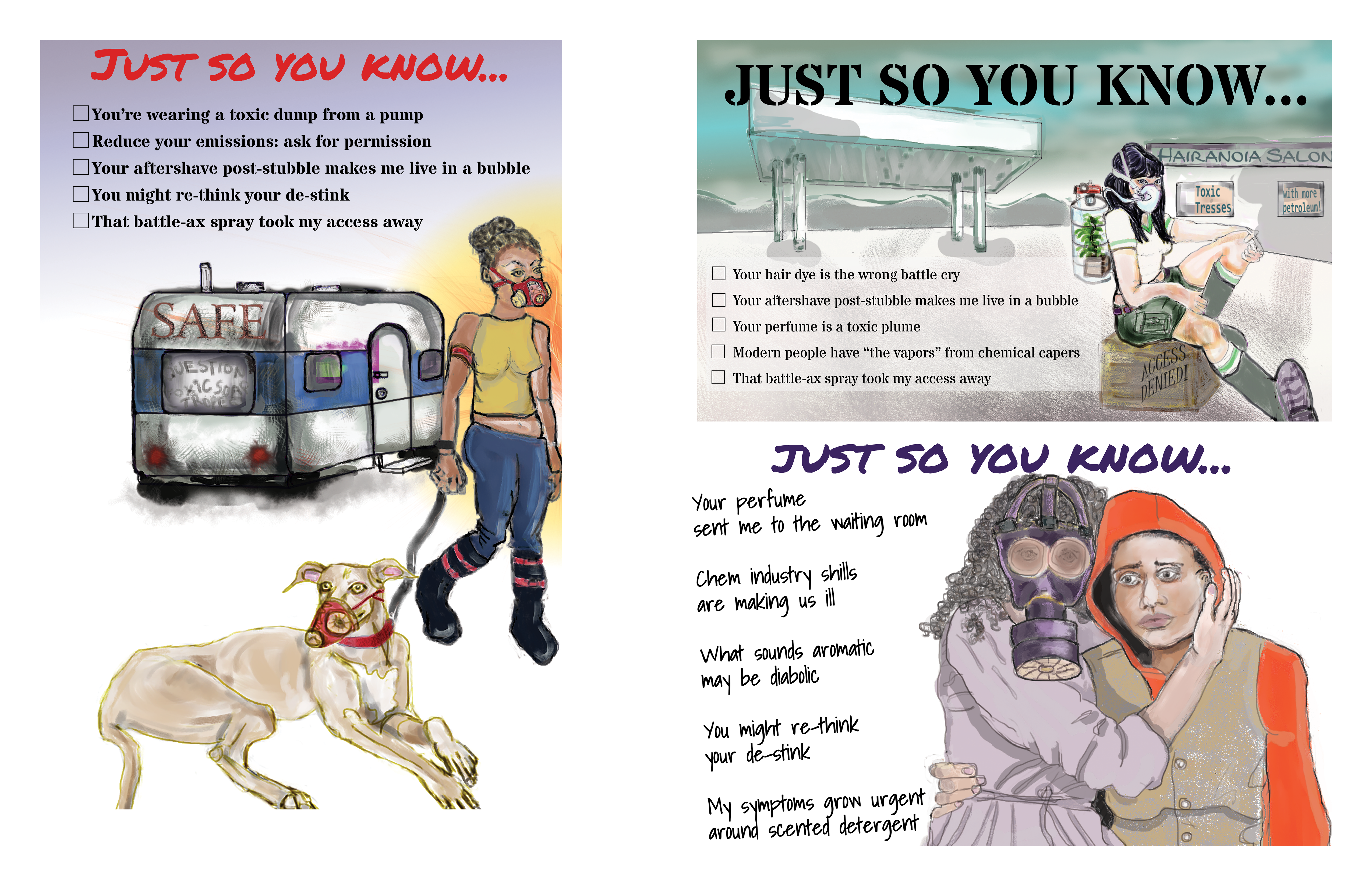
Substantive Caption:
Allergist/immunologist Claudia Miller has proposed that, once individuals reach a threshold of total “body burden,” they are susceptible to TILT (Toxicant Induced Loss of Tolerance) thereby reacting to small amounts of previously tolerated chemicals. Diagnosis of MCS (Multiple Chemical Sensitivity (MCS) for TILT-ed individuals is more common among white populations, suggesting a disparity in treatment among minorities. The educational and activist aims of these postcards, commissioned by the Chemical Entanglements Project at UCLA’s Center for the Study of Women, includes acknowledging people of color who have been at the forefront of environmental justice efforts. All three images created by disability artist Peggy Munson (who herself has MCS) feature individuals with masks over the faces. One card features an Asian woman resting at an abandoned gas station repurposed as a beauty salon, to draw the connection between toxic ingredients in many salon products and their petroleum rootstocks. Another image shows an African American woman and her dog as they debark from a camper with a label “SAFE” scrawled on its rear. This card acknowledges the difficulty for those with MCS to find safe housing because of off-gassing chemicals in building materials. The third postcard presents a woman wearing a respirator, her arms around an African American gender non-binary individual--an image of mutual alliance and support. Each postcard has a set of check-boxes that evoke the medical questionnaires given to patients. Here, the sender of the postcard would put an “x” in a box linked to phrases such as “My symptoms grow urgent around scented detergent,” and “Modern people have the vapors from chemical capers” that serve as messages warning that access for those with MCS runs inversely to the distribution of accessory fragrances by chemical manufacturers.
Design Statement:
We present this visualization because:
By commissioning art from someone in the Multiple Chemical Sensitivity/ Environmental Illness community, we hoped to make insider knowledge available to a wider public.
It represents our naiveté around what constituted the “low hanging fruit” in explaining the under-regulation of endocrine disrupting chemicals (EDCs) to a wider public. The sources of EDCs are myriad. We thought it surprising, and little known, that EDCs comprise common cosmetics, toiletries and household cleaners whose scents are advertised to odor-fearing consumers. We mistakenly assumed that the general population would only need to be made aware of the potential hazards in “fragranced” products. However, these images struck many as more offensive than informative.
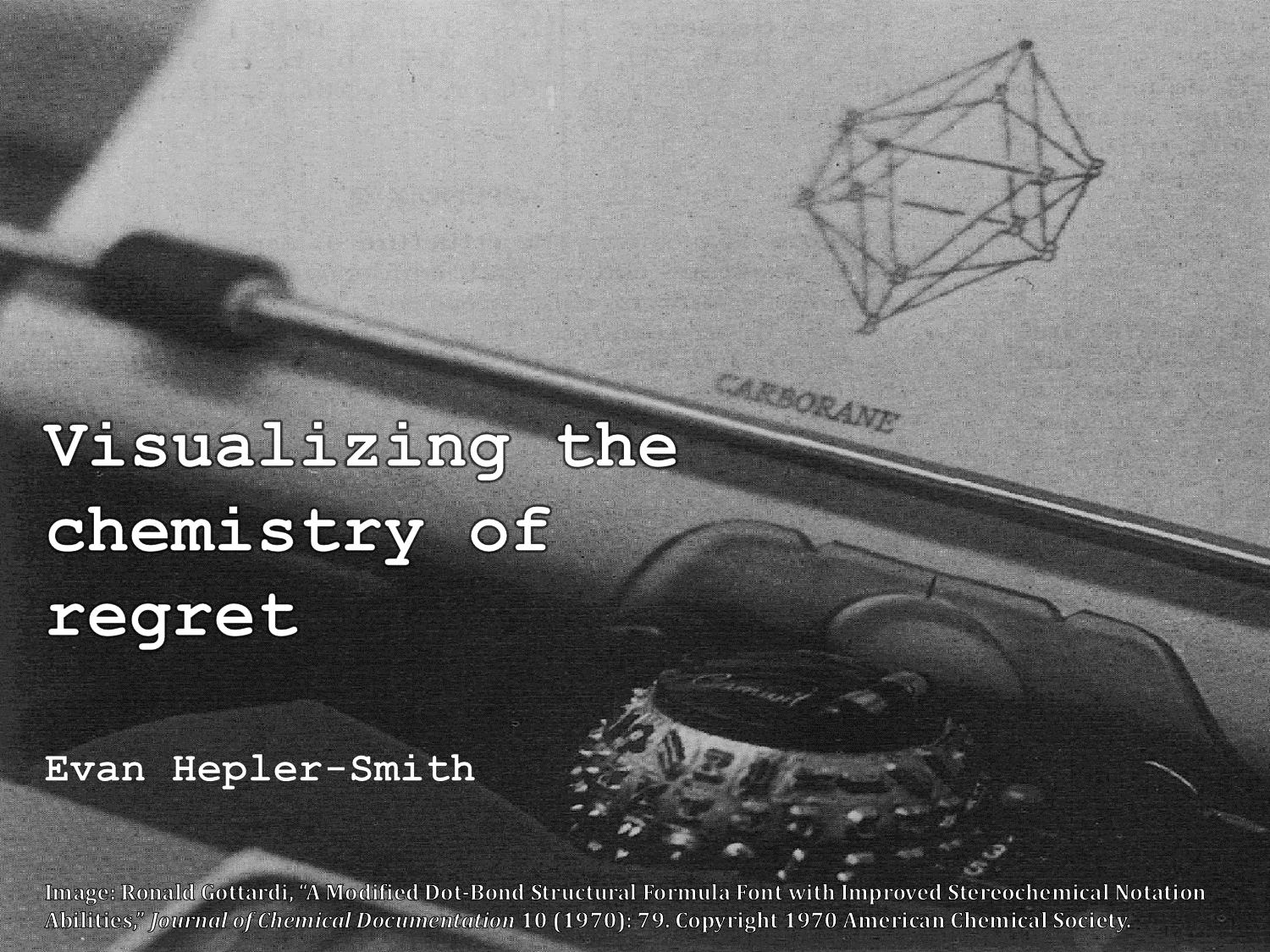
My challenging toxic subject is the molecule. Not any particular nanoscale unit of potentially hazardous substance, nor any particular substance in the aggregate. Rather, I am interested in the material and historical grounds for the peculiar idea that molecules and only molecules may be the proximate causes of (chemical) toxicity. This principle that a toxin is a chemical is a molecule defines the stage on which most modern dramas of toxic chemical perceptibility and epistemology play out. It sustains, among other things, the perverse pattern of "regrettable substitution" (whence this essay's title), also known as "chemical whack-a-mole"—the replacement of a hazardous substance by a substitute that turns out to be just as toxic. The origins of this history lie in visualization: the late 19th century convention (much the same today) of representing chemical substances using doodles of letters, representing atoms, and lines, representing bonds. The principle of toxin-as-chemical-as-molecule came about through the transformation of such doodles into fixed chemical names and notation. Deployed within the authoritative information technologies of chemistry, from many-volume print reference works to present-day digital databases, this molecular vocabulary ordered the chemical world for the convenience of chemists and, especially, the synthetic chemicals industry. I would like to reverse this process. By foregrounding the contingency of the molecule as toxic agent, I wish to open space for remapping environmental toxicity along dimensions new and forgotten, such as that of 19th century Alsatian chemist Charles Gerhardt, for whom chemicals were beings “defined by their metamorphoses, that is, by their past or by their future."
Evan Hepler-Smith
Boston College
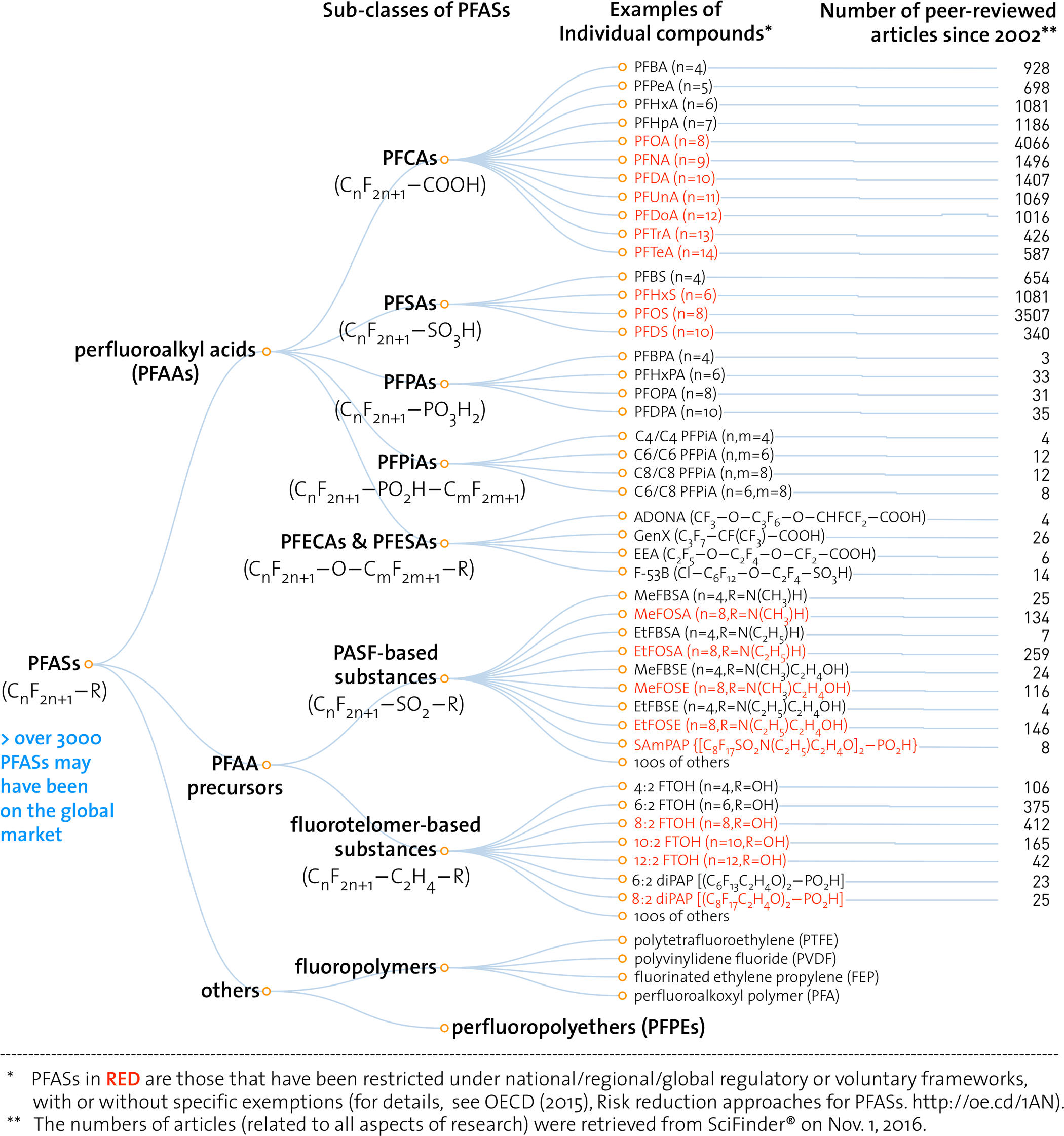
Substantive Caption:
“PFASs as a whole, much more than solely PFOS, PFOA, and their precursors, are an intractable, potentially never-ending chemicals management issue” (Wang 2017, 2511).
This image depicts the “family tree” of the chemicals PFOS (perfluoroctasulfonic acid) and PFOA (perfluorooctanoic acid). PFOA and PFOS are persistent environmental chemicals associated with a range of toxic effects including increased incidence of liver disease, thyroid disease, high cholesterol, decreased vaccine efficacy, decreased fertility, pre-eclampsia, and several types of cancer (ATSDR 2018). PFOS—formerly the key ingredient in the stain-resistant coating Scotchgard—is among the two-dozen persistent organic pollutants restricted or banned under the UN’s Stockholm Convention. PFOA—a key constituent in Teflon production until the mid-2000s—is under consideration for addition to the Stockholm Convention in April 2019.
As these two toxic chemicals have been phased out, they have been replaced, Hydra-like, by diverse related chemicals from the broader class of PFCs or PFASs (perfluoro chemicals / per- and polyfluoroalkyl substances). Environmental toxicologists are concerned that the same structural similarities that make other PFASs useful substitutes for the industrial uses of PFOA and PFOS may also make the entire class just as hazardous as these two substances that have become major public health concerns. This figure, from a 2017 review article addressing PFAS toxicology, is intended to illustrate the molecule-by-molecule breadth of this toxic hazard and the comparatively narrow scope of research and regulation. The molecule-by-molecule detail of the figure is overwhelming, inscrutable, frustrating, intractable. That is the point. The authors wish to argue that, as long as environmental science, law, and politics hew to molecule-by-molecule conceptions of what's toxic, the task of controlling environmental toxicity will remain overwhelming, inscrutable, frustrating, and intractable, too.
The authors of this article explain, “The most common current industrial practice of phasing out one PFAS is to replace it with another (or multiple other) structurally similar PFAS. Such a strategy is easier and less costly than identifying a nonfluorinated substance to be used in the same or similar process (i.e., chemical replacement) or inventing a new process that does not require PFASs (i.e., functionality replacement).…. [B]ut such a replacement strategy will not solve issues in relation to PFASs as a whole group—it will only increase the numbers of PFASs on the market and the difficulties in tracking them” (Wang 2017).
This image portrays environmental toxicology and toxic substances regulation as trapped in a molecular double bind. On the one hand, the quantity of studies dedicated to PFOA and PFOS attest to how much work it takes to begin to understand the long-term, low-dose toxicity of a specific chemical compound—let alone to take action to address it. On the other hand, the molecule-by-molecule list of PFASs at right illustrates how focusing on specific compounds risks missing the chemical forest for the molecular trees. And yet this forest—the white noise of ubiquitous multiple chemical exposure (Murphy 2006)—is precisely the white noise that makes it take so much work to pick out a toxic signal associated with an individual substance in the first place.
In sum, according to this figure, there are too many molecules to know, and it’s very hard to know anything at all about any of them, in large part because there are so many of them to know. This is a fruitful starting point for asking historical and ethnographic questions about the ontology of the agents of environmental toxicity. Where did we get the idea that the environment (or the hazardous anthropogenic bits of it, anyway) is made up of molecules? What is a molecule? Are there alternative ontologies on offer, within or outside of the chemical and toxicological sciences?
One place to start: The impression that there is just too much to know is a general feature of the “informating of environmentalism” (Fortun 2004). Historically, such concerns have tended to emerge in the wake of novel technologies that afford new practices and imaginaries and scales of information management (Blair 2010).
Design Statement:
In this essay, I take data visualization and image-based arguments as subject matter for historical and ethnographic analysis. My particular interest is in the relationship between, on the one hand, genres and conventions for making and interpreting images, and on the other hand, databases and reference works containing data that gets visualized in such images. By attending to the connection between information infrastructure (Bowker and Star 1999) and image-making, we can investigate the interdependence between the ways data gets stored and the “ways in which [a community of practice] attunes to, interacts with, and shapes its objects in its various and varied practices.” (Mol 2002, vii; see also Hacking 2002). To oversimplify: visualization method + data structure = ontology.
Methodologically, this essay aims to model the sort of approach that ethnographers and historical ethnographers might apply reflexively to assess their own methods of data visualization and image-making—especially methods drawing on data and techniques developed within other fields. My work shows how, as chemical databases and visualization methods are taken up outside their fields of origin, cross-disciplinary user communities can fall into a “certainty trough” (Mackenzie 1990), taking inscriptions created as index terms (where can you find data about a certain substance?) and granting them ontological status (what substance is this data about?). This is not necessarily a bad way of enacting the world, but we should be aware that we’re doing it!
Cover image
I want to avoid the temptation of getting lost in a hall of mirrors of representation and re-mediation, when it comes to this screenshot of a database-accessed copy of a digital scan of a newsmagazine article with a figure reproducing a soft-focus photograph of a chemical typewriter typing a diagrammatic representation of a chemical substance that never was. Instead, I want to emphasize the proliferation of articles containing figures like this in mid-20th century chemical journals, extolling the capacity of this or that chemical typewriter to type legible and interpretable structural formulas rather than hand-drawing them (or employing a professional graphical artist to do so). Across pen-and-paper, chalk-and-slate, mechanical, and digital media, the genre of the structural formula representing the molecular structure of a chemical substance has remained remarkably consistent since the late 1860s. Digital ethnographers might ask whether phenomena of interest are best explained in terms of digital media, in terms of genre, and/or along other dimensions of continuity and change.
This image
The taxonomic tree is a common visual genre for expressing a collection of relationships. Taxonomic trees reflect, imply, or constitute a hierarchical classification, pinning down entities to specific positions within it. Yet these trees also afford a certain flexibility, permitting the viewed to lump or split, emphasize sameness or difference, depending on which specific taxa or taxonomic level one chooses to privilege. Indeed, natural historians have at times interpreted trees as illustrations of the unreality of species as natural kinds. By this view, what’s arboreal is arbitrary.
Rhetorically, such images are frequently employed to overwhelm, confronting the viewer with a surfeit of complexity, employing an all-encompassing order to emphasize the incomprehensible scope of specifics. The tree in this figure, for instance, presents an impression of order-cum-overload supporting the article authors’ argument that the variety of fluorine-rich synthetic chemical substances subsumed in this hierarchy is in part responsible for their “Never-Ending Story” (per the article’s title) as persistent organic pollutants.
References:
ATSDR (Agency for Toxic Substances and Disease Registry, United States Department of Health and Human Services). 2018. Toxicological Profile for Perfluoroalkyls (Draft for Public Comment). https://www.atsdr.cdc.gov/toxprofiles/tp200.pdf.
Blair, Ann. 2010. Too Much to Know: Managing Scholarly Information before the Modern Age. New Haven: Yale University Press.
Bowker, Geoffrey C., and Susan Leigh Star. 1999. Sorting Things Out: Classification and Its Consequences. Cambridge, MA: MIT Press.
Fortun, Kim. 2004. “From Bhopal to the Informating of Environmentalism: Risk Communication in Historical Perspective.” Osiris 19: 283–96. doi: 10.1086/649407.
Hacking, Ian. 2002. Historical Ontology. Cambridge, MA: Harvard University Press.
Mackenzie, Donald A. 1990. Inventing Accuracy: A Historical Sociology of Nuclear Missile Guidance. Cambridge, Mass: MIT Press.
Mol, Annemarie. 2002. The Body Multiple: Ontology in Medical Practice. Durham: Duke University Press.
Murphy, Michelle. 2006. Sick Building Syndrome and the Problem of Uncertainty: Environmental Politics, Technoscience, and Women Workers. Durham: Duke University Press.
Wang, Zhanyun et al. 2017. “A Never-Ending Story of Per- and Polyfluoroalkyl Substances (PFASs)?.” Environmental Science & Technology 51 (5): 2508–18. doi: 10.1021/acs.est.6b04806.
(Revision of May 9, 2019)
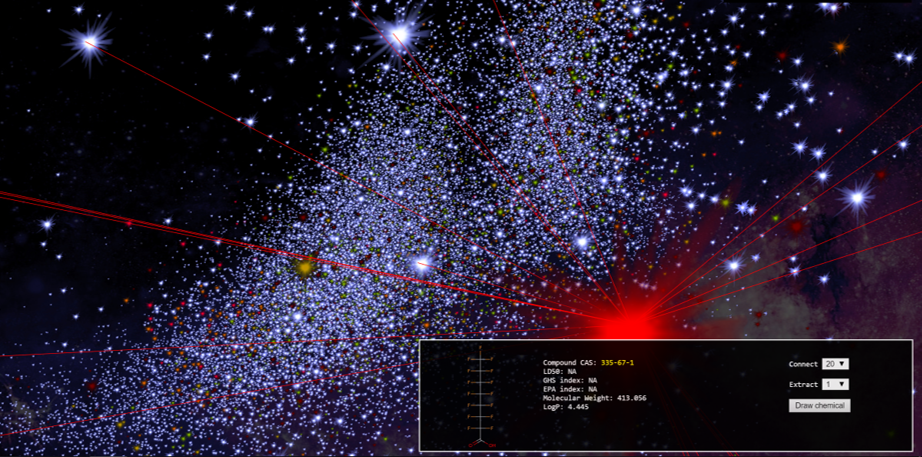
Substantive Caption:
Screen capture from the web app ChemMaps, depicting a view of “chemical space” from the perspective of PFOA. Each “star” in this map represents a chemical compound of a distinct molecular identity. The relative positions of these stars indicate structural similarity, according to “a complex compendium of 1D, 2D and 3D pre-computed molecular descriptors to generate the chemical space in three dimensions” (Borrel, Kleinstreuer, and Fourches 2018). Based on the assumption that chemical properties are correlated with molecular structure—a bedrock of modern organic chemistry—the proximity of substances in this map is supposed to be an index of chemical and toxicological similarity. Like most work in cheminformatics, ChemMaps was originally designed to expedite drug discovery. However, “ChemMaps.com aims to become the go-to website for anyone wanting to search, mine or visualize chemical space” (Borrel, Kleinstreuer, and Fourches 2018). This includes those concerned about environmental toxicity of chemicals like the PFASs.
Here, hovering just over the shoulder of PFOA, the viewer floats in a purely molecular galaxy. This chemical holism purports to represent the constituents of the material world of Teflon and Scotchgard and cancer. However, this form of visualization unintentionally dramatizes how far removed this holism of molecules is from the world of materials. It is one realization of a trend that the philosopher François Dagognet associated with the representation of chemical substances in abstract molecular terms: “whereas the poets have always suffered from the gap between things and signs, chemistry tranquilly effects the miracle of their coincidence. The neologisms, however, lose their attachment with sensible reality, qualities, and appearances. In order to be able to go to the depths of substances, on the ocean of their relationships, it’s necessary to break the moorings. The learned words, kinds of algebraic polynomials, cease then to touch us. Uprooted, they address themselves only to the intelligence of structures.” (Dagognet 2002 [1969], 158).
Framing the problem of environmental toxicity as a problem of information overload tends to suggest computational solutions. Molecules are extremely well adapted to computer modeling and large-scale comparisons. But the intensification of computational methods is suspiciously analogous to the intensified production of new, putatively safer chemicals as a solution to environmental toxicity. It may be that the computational tractability of molecules is an index of their intractability as toxic subjects. Perhaps here, as in other domains, “the simplification of ontology has led to the enormous complication of epistemology,” (Viveiros de Castro 2004).
Design Statement:
This image is a data visualization expressing calculated estimates of toxicity-relevant properties of chemical substances. Like most (all?) visualizations, it is a visual metaphor: here, chemical substances are stars, and spatial proximity is toxicological similarity. As Lily Kay (2000) points out, scientific metaphors have ontological force – the ways they render the world may beget ways of interacting with and remaking it. Molecular structures are abstractions, not material substances; one might define chemical identity in many other ways. The visual metaphor of the star map enforces a conception of chemical individuality that strongly privileges the molecular structure – each molecule, forever alone and itself, in the chemical heavens.
Two methodological points: first, ethnographers may wish to reflect on the implications of the visual metaphors they employ in data visualization and other image-making practices. Second, if we wish to create ethnographic images that contest and situate putative views from nowhere, we should be careful to avoid (or at minimum ironize) data visualizations practices that reproduce such a view.
References:
Borrel, Alexandre, Nicole C. Kleinstreuer, and Denis Fourches. 2018. “Exploring Drug Space with ChemMaps.Com.” Bioinformatics 34 (21): 3773–75. doi: 10.1093/bioinformatics/bty412.
Dagognet, François. 2002 [1969]. Tableaux et langages de la chimie : essai sur la représentation. Seyssel: Champ Vallon.
Kay, Lily E. 2000. Who Wrote the Book of Life?: A History of the Genetic Code. Stanford: Stanford University Press.
Viveiros de Castro, Eduardo Batalha. 2004. “Exchanging Perspectives: The Transformation of Objects into Subjects in Amerindian Ontologies.” Common Knowledge 10 (3): 463–484. doi: 10.1215/0961754X-10-3-463.
(Revision of May 9, 2019)
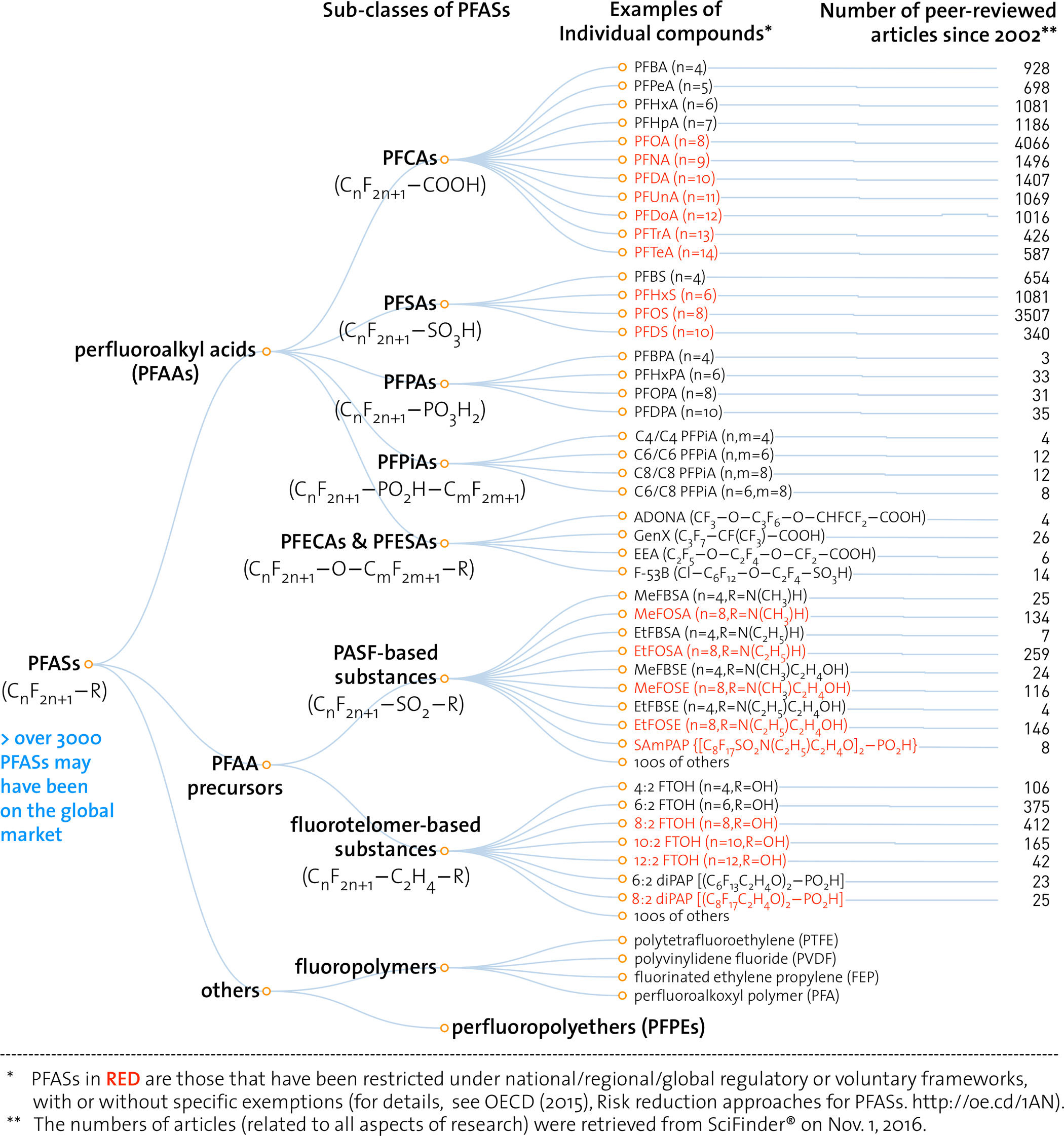
Substantive Caption:
“PFASs as a whole, much more than solely PFOS, PFOA, and their precursors, are an intractable, potentially never-ending chemicals management issue” (Wang 2017, 2511).
This image depicts the “family tree” of the chemicals PFOS (perfluoroctasulfonic acid) and PFOA (perfluorooctanoic acid). PFOA and PFOS are persistent environmental chemicals associated with a range of toxic effects including increased incidence of liver disease, thyroid disease, high cholesterol, decreased vaccine efficacy, decreased fertility, pre-eclampsia, and several types of cancer (ATSDR 2018). PFOS—formerly the key ingredient in the stain-resistant coating Scotchgard—is among the two-dozen persistent organic pollutants restricted or banned under the UN’s Stockholm Convention. PFOA—a key constituent in Teflon production until the mid-2000s—is under consideration for addition to the Stockholm Convention in April 2019.
As these two toxic chemicals have been phased out, they have been replaced, Hydra-like, by diverse related chemicals from the broader class of PFCs or PFASs (perfluoro chemicals / per- and polyfluoroalkyl substances). Environmental toxicologists are concerned that the same structural similarities that make other PFASs useful substitutes for the industrial uses of PFOA and PFOS may also make the entire class just as hazardous as these two substances that have become major public health concerns. This figure, from a 2017 review article addressing PFAS toxicology, is intended to illustrate the molecule-by-molecule breadth of this toxic hazard and the comparatively narrow scope of research and regulation.
The authors of this article explain, “The most common current industrial practice of phasing out one PFAS is to replace it with another (or multiple other) structurally similar PFAS. Such a strategy is easier and less costly than identifying a nonfluorinated substance to be used in the same or similar process (i.e., chemical replacement) or inventing a new process that does not require PFASs (i.e., functionality replacement).…. [B]ut such a replacement strategy will not solve issues in relation to PFASs as a whole group—it will only increase the numbers of PFASs on the market and the difficulties in tracking them” (Wang 2017).
Design Statement:
This image portrays environmental toxicology and toxic substances regulation as trapped in a molecular double bind. On the one hand, the quantity of studies dedicated to PFOA and PFOS attest to how much work it takes to begin to understand the long-term, low-dose toxicity of a specific chemical compound—let alone to take action to address it. On the other hand, the molecule-by-molecule list of PFASs at right illustrates how focusing on specific compounds risks missing the chemical forest for the molecular trees. And yet this forest—the white noise of ubiquitous multiple chemical exposure (Murphy 2006)—is precisely the white noise that makes it take so much work to pick out a toxic signal associated with an individual substance in the first place.
In sum, according to this figure, there are too many molecules to know, and it’s very hard to know anything at all about any of them, in large part because there are so many of them to know. This is a fruitful starting point for asking historical and ethnographic questions about the ontology of the agents of environmental toxicity. Where did we get the idea that the environment (or the hazardous anthropogenic bits of it, anyway) is made up of molecules? What is a molecule? Are there alternative ontologies on offer, within or outside of the chemical and toxicological sciences?
One place to start: The impression that there is just too much to know is a general feature of the “informating of environmentalism” (Fortun 2004). Historically, such concerns have tended to emerge in the wake of novel technologies that afford new practices and imaginaries and scales of information management (Blair 2010).
References:
ATSDR (Agency for Toxic Substances and Disease Registry, United States Department of Health and Human Services). 2018. Toxicological Profile for Perfluoroalkyls (Draft for Public Comment). https://www.atsdr.cdc.gov/toxprofiles/tp200.pdf.
Blair, Ann. 2010. Too Much to Know: Managing Scholarly Information before the Modern Age. New Haven: Yale University Press.
Fortun, Kim. 2004. “From Bhopal to the Informating of Environmentalism: Risk Communication in Historical Perspective.” Osiris 19: 283–96. doi: 10.1086/649407.
Murphy, Michelle. 2006. Sick Building Syndrome and the Problem of Uncertainty: Environmental Politics, Technoscience, and Women Workers. Durham: Duke University Press.
Wang, Zhanyun et al. 2017. “A Never-Ending Story of Per- and Polyfluoroalkyl Substances (PFASs)?.” Environmental Science & Technology 51 (5): 2508–18. doi: 10.1021/acs.est.6b04806.
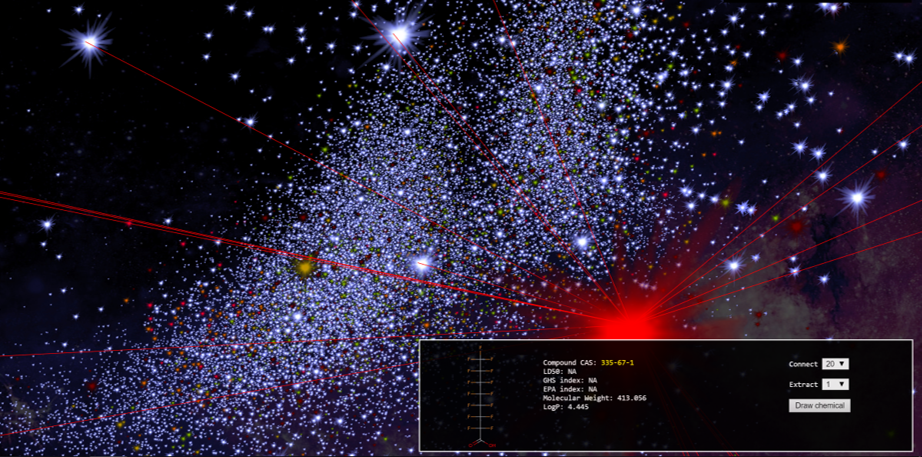
Substantive Caption:
Screen capture from the web app ChemMaps, depicting a view of “chemical space” from the perspective of PFOA. Each “star” in this map represents a chemical compound of a distinct molecular identity. The relative positions of these stars indicate structural similarity, according to “a complex compendium of 1D, 2D and 3D pre-computed molecular descriptors to generate the chemical space in three dimensions” (Borrel, Kleinstreuer, and Fourches 2018). Based on the assumption that chemical properties are correlated with molecular structure—a bedrock of modern organic chemistry—the proximity of substances in this map is supposed to be an index of chemical and toxicological similarity. Like most work in cheminformatics, ChemMaps was originally designed to expedite drug discovery. However, “ChemMaps.com aims to become the go-to website for anyone wanting to search, mine or visualize chemical space” (Borrel, Kleinstreuer, and Fourches 2018). This includes those concerned about environmental toxicity of chemicals like the PFASs.
Here, hovering just over the shoulder of PFOA, the viewer floats in a purely molecular galaxy. This chemical holism purports to represent the constituents of the material world of Teflon and Scotchgard and cancer, but this form of visualization dramatizes how far away we are. It is one realization of a trend that the philosopher François Dagognet associated with the representation of chemical substances in abstract molecular terms: “whereas the poets have always suffered from the gap between things and signs, chemistry tranquilly effects the miracle of their coincidence. The neologisms, however, lose their attachment with sensible reality, qualities, and appearances. In order to be able to go to the depths of substances, on the ocean of their relationships, it’s necessary to break the moorings. The learned words, kinds of algebraic polynomials, cease then to touch us. Uprooted, they address themselves only to the intelligence of structures.” (Dagognet 2002 [1969], 158).
Design Statement:
References:
Borrel, Alexandre, Nicole C. Kleinstreuer, and Denis Fourches. 2018. “Exploring Drug Space with ChemMaps.Com.” Bioinformatics 34 (21): 3773–75. doi: 10.1093/bioinformatics/bty412.
Dagognet, François. 2002 [1969]. Tableaux et langages de la chimie : essai sur la représentation. Seyssel: Champ Vallon.
Viveiros de Castro, Eduardo Batalha. 2004. “Exchanging Perspectives: The Transformation of Objects into Subjects in Amerindian Ontologies.” Common Knowledge 10 (3): 463–484. doi: 10.1215/0961754X-10-3-463.
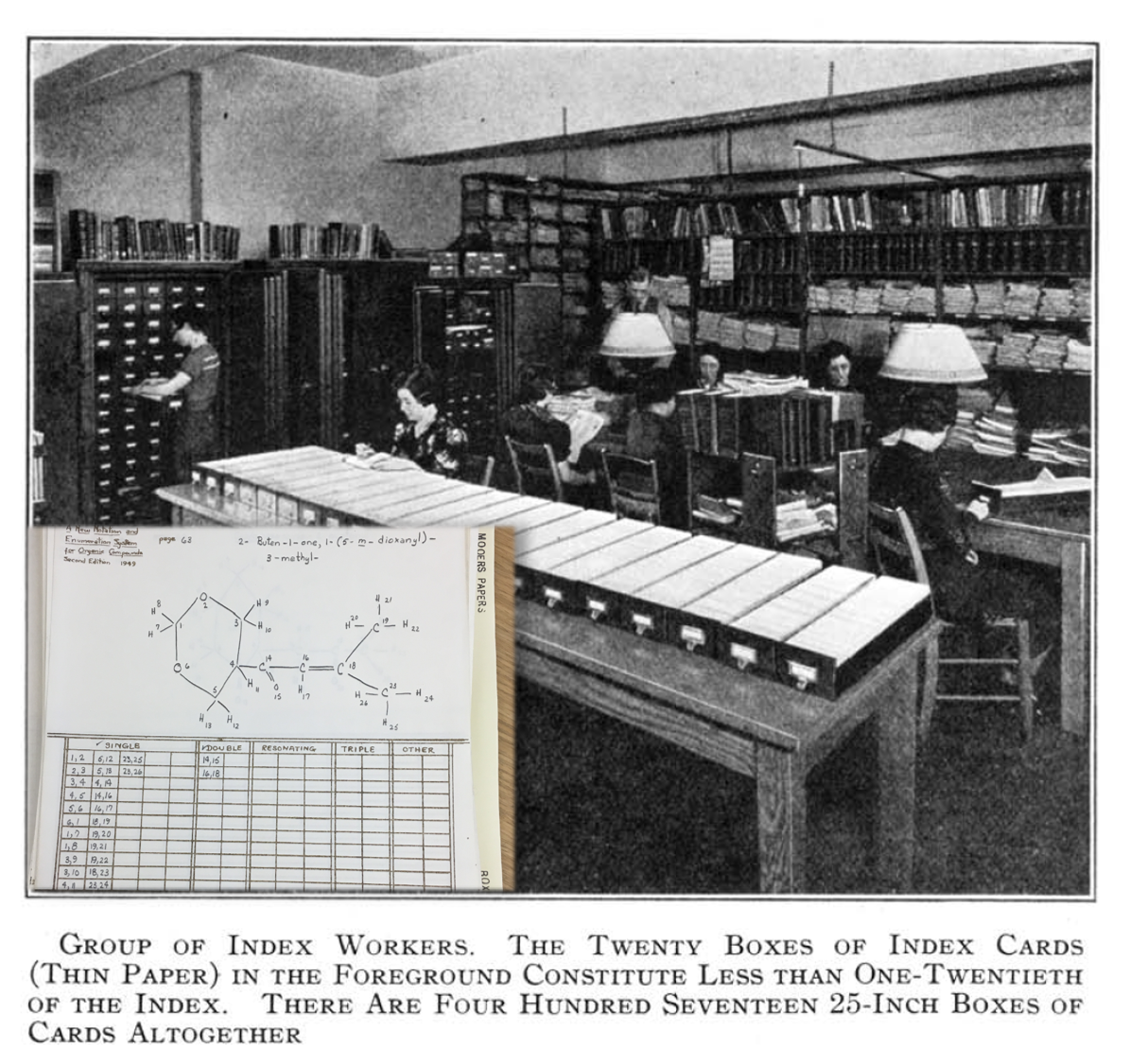
Substantive Caption:
The main image depicts the editorial offices of Chemical Abstracts, circa 1938. For most of the 20th century and through the present-day, the abstract journals, collective indexes, and databases of Chemical Abstracts (now Chemical Abstracts Service, or CAS) have been the authoritative source for bibliographic and regulatory information about chemical substances and the chemical sciences, including allied fields such as toxicology. In this image, “index workers” are engaged in compiling an annual or decennial index of the publication. The vast majority of these cards refer to individual chemical substances rather than subject headings or author names. Much index labor involved writing, rewriting, cross-referencing, and error-checking the systematic chemical names that were the key to the whole enterprise, since they allowed for the arrangement of hundreds of thousands (today hundreds of millions) of substances in chemically-meaningful alphabetical order. This work was particularly challenging because the research chemists who wrote the journal articles abstracted and indexed in Chemical Abstracts often did not themselves use systematic names. This was both because the names were cumbersome and because the uniform chemical ontology that they expressed was sometimes a poor fit for how chemists defined the substances that their research addressed.
“Among personal characteristics for this type of work accuracy perhaps should rank highest, and with that conscientiousness, patience, a meticulous attentiveness to detail (without a loss of perspective of relative values, since a great deal of work has to be turned out, at times under considerable pressure), power of concentration, good judgment, and interest in words as words, a love of puzzles and of guessing and digging out elusive ideas, meanings, words, and formulas. An interest in things rather than people is likely to lead to greater satisfaction in this type of work, since the opportunities for personal professional contacts outside the office are relatively few. The analytical rather than the creative type is probably best suited to this kind of work. Good eyes (at least strong ones) are absolutely essential, while the ability to sit hour after hour without much relief is a requirement not to be laughed off. Work of this nature is not for the overly energetic or restless person” (Scott 1938, 275; italics in original).
The inset image depicts a form of the sort that was used when CAS re-created this whole operation on digital computers during the 1960s.
Design Statement:
Molecular identity is not given by nature. Rather, it was made in meeting rooms and editorial offices, for the purposes of organizing information about chemical substances, in order to support research and development within the turn of the century synthetic chemicals industry (Hepler-Smith 2015a; Hepler-Smith 2015b; Hepler-Smith 2016). And both making and maintaining this system of molecular identity took (and takes) a whole lot of *work*.
My intention in juxtaposing these images is to direct historical and ethnographic attention to the situated practices—including especially bureaucratic practices—through which the simplicities, complexities, and uncertainties of environmental toxicity are constituted. They are typically taken to be baked into the material nature of chemical substances and bodies. To a certain degree, they are; but they are also the product of a way of ordering the world of substances that I am calling “molecular bureaucracy” (Hepler-Smith 2019). The institutions, practices and technologies that render the world molecular (cf. Myers 2015) entail simplifications, frustrations, fortuitous affordances, and regrettable consequences. Training our vision on easily-overlooked legal definitions, information technologies, administrative procedures, clerical labor, and nomenclature conventions can help shed light on why toxic subjects get visualized in the ways they do.
References:
Hepler-Smith, Evan. 2015. "'Just as the Structural Formula Does': Names, Diagrams, and the Structure of Organic Chemistry at the 1892 Geneva Nomenclature Congress." Ambix 62 (1): 1-28. doi: 10.1179/1745823414Y.0000000006.
Hepler-Smith, Evan. 2015b. “Systematic Flexibility and the History of the IUPAC Nomenclature of Organic Chemistry.” Chemistry International 37 (2): 10-14. doi: 10.1515/ci-2015-0232.
Hepler-Smith, Evan. 2016. “Changing Names and Naming Change: Transformations in the ‘International Machinery’ of Chemical Information.” Proceedings of the International Workshop on the History of Chemistry, March 2-4 2015, Tokyo. 68-76. http://kagakushi.org/iwhc2015/proceedings/.
Hepler-Smith, Evan. 2019. "Molecular Bureaucracy: Toxicological Information and Environmental Protection." Environmental History 24 (3). Forthcoming.
Myers, Natasha. 2015. Rendering Life Molecular: Models, Modelers, and Excitable Matter. Durham: Duke University Press.
Scott, Janet D. 1938. “The Chemist at Work. XIV. My Work with Chemical Abstracts.” Journal of Chemical Education 15 (6): 271–75. doi: 10.1021/ed015p271.

Substantive Caption:
This image points to an instance of “astroturfing” as a practice of converting economic capital into political power through the purchase and/or production of an illusion of grassroots support. The image is composed of a juxtaposition of a photograph of a New Orleans City Council meeting with a screenshot taken from the company website of Crowds on Demand, a freelance publicity firm that specializes in contracting crowds of actors to influence legislation and sway public opinion. In this particular instance, Crowds on Demand was contracted to influence the New Orleans City Council to approve the construction of a new natural-gas power plant in New Orleans East, a predominantly immigrant and minority community that has a long history of struggling against similar instances of environmental racism. The fallout from this astroturfing campaign, as well as the failure of the City Council to respond adequately, has called the very possibility of a meaningful democratic politics into question. The image thus attempts to make use of this particular breach of trust to exemplify and discuss astroturfing as a toxic force that deteriorates the meaning of symbolic forms and therein leaches the potential for meaningful political action.
In 2018, Crowds on Demand was indirectly contracted by Entergy (a New Orleans based energy company) to hire dozens of professional actors to create the impression of strong grassroots support for a new, $211 million natural-gas plant in east New Orleans. Despite attempts to obscure their involvement through subcontractors, the combined evidence garnered through the investigations of The Lens (a local non-profit newsroom) and a city-commissioned law firm suggests that the company intentionally financed the hiring of false advocates to overcome the otherwise formidable grassroots opposition taking hold in the communities living in close proximity to proposed construction site. On two occasions, these trained actors flooded New Orleans’ City Council meetings, providing fraudulent testimony as false constituents while simultaneously preempting actual constituents from entering the meeting and participating in the discussion. The photograph of one such meeting—located the bottom of the combined image—shows the numerous bright-orange shirts and bold printed signs, held by a diverse group of inconspicuous looking actors, that provided a convincing representation of popular support for the new plant. What cannot be captured here, however, are the lists of talking points developed and given to the actors by Crowds on Demand, along with non-disclosure agreements and strict instructions to avoid the media and deny any accusations of monetary compensation for their appearance.
The disciplining of deception in this way enabled Crowds on Demand’s involvement to remain concealed until after the City Council had already approved the controversial power plant in March of 2018. However, with numerous convergences of evidence of Entergy’s willing financial connection to this bout of political theater, crowds of disaffected citizens—this time authentic—soon gathered in protest, calling for the City Council to respond by holding a vote to repeal the plant’s approval. The Council initially appeared to be receptive to this idea but later refused a second vote on the issue, choosing instead to impose a $5 million fine on Entergy for their deceptions. This disappointment prompted further skepticism of the City Council’s allegiances, a mistrust not unwarranted, given that the majority of current council members had either received substantial campaign contributions from Entergy or had previously worked for the energy company. Thus, in addition to the safely-assumed public health impacts of the off-gassed chemicals of the future power plant, this coming to light of evidence of corruption and professionally organized deceit has fomented a sense of fatalist cynicism amongst residents of New Orleans East. Take, for example, the words of one local activist, Ming Nguyen: “We’ve done this community-based process, but I don’t know if it ever mattered, because this decision was made before there was ever a hearing.” Thus, perhaps this instance of astroturfing was a double deception, a falsification of grassroots support that enabled the City Council to act as if they had been persuaded, when in reality, in order to protect the City's vested interests, they were always already going to approve the plant. I am neither able nor particularly interested in endorsing or denouncing this view. Aside from whether or not the New Orleans municipal government is actually plagued with this degree of corruption, the fact that it is being posited cuts to the core of what I mean by post-trust.
One way of understanding toxicity is as a reactive force, a force of deterioration, with the effect of rendering the active passive; toxicity as a leaching of vitality. As such, toxicity is not an essential but a relational property of that which inhabits channels of communication and impedes or alters the signals between senders and receivers, broadly conceived. Like the parasite (Kockelman 2010, Serres 2007), its effect is not simply upon an object or a "host" as a single unit. Instead it takes effect within a system of relations as an impedance, or a corrosive agent. For instance, neurotoxins work by either reducing the production of neurotransmitters or by blocking the reception sites between neurons. Hemotoxins interrupt cardiovascular system by disrupting blood coagulation processes, therein precluding its normal flow. Analogously, the campaigns of Crowds on Demand—and the practice of astroturfing more generally—are toxic because they inhabit the gaps, the interstices of symbolic channels of democratic political participation so as to filter, jumble, or overload these channels in ways that circumvent the democratic process.
If we take democracy to be a uniquely symbolic and performative mode of politics (Matynia 2009), then we must also appreciate the fundamental role of our capacity to trust in the sincerity of these symbolic performances. Like a well-camouflaged parasite, Crowds on Demand hides within the established symbolic forms of grassroots-based political expression (protests, rallies, testimony, letters to congress, etc.), all the while diminishing their value. It sustains itself on the very same trust in the democratic process that it undermines. Accordingly, Ming Nguyen’s quote perfectly encapsulates the potentially toxic effect of Post-trust politics. It denotes an acquiescence, a sense of loss and resentment, of isolation and futility that is symptomatic of losing faith in one’s capacity to act.
Design Statement:
This image is an illustration of a mode of political toxicity that takes effect through the manipulation of symbolic forms. It serves as an example, a case in point, of how the inherently symbolic grounds of democratic political action leaves its modes and forms of representation vulnerable to distortion. The ethnographic utility of this image is rooted in its ability to provide a “thicker” conception of what astroturfing is as a concept and practice by providing the viewer with visual access to a single, exemplary manifestation. It manages to do so by taking advantage of the ethnographic technique of juxtaposition. The screenshot of website shows a number of grassroots political tactics that Crowds on Demand lists as potential symbolic forms available to mimicry. The image of the city council meeting then provides a snap shot of this practice, capturing the likeness of this imitation in the moment. Illustrations like these are useful in ethnography to add precision and substance to the concept, situation, or process being described. That is, much like an ethnographic vignette, they enable the ethnographer to reduce the ambiguity of theory by detailing a particular situation, event, or episode of interest.
References:
“Crowds on Demand.” n.d. Crowds On Demand. Accessed May 10, 2019. https://crowdsondemand.com/.
Kockelman, Paul. 2010. “Enemies, Parasites, and Noise:How to Take Up Residence in a System Without Becoming a Term in It.” Journal of Linguistic Anthropology 20 (2): 406–21. https://doi.org/10.1111/j.1548-1395.2010.01077.x.
Matynia, Elżbieta. 2009. Performative Democracy. The Yale Cultural Sociology Series. Boulder: Paradigm Publishers.
Serres, Michel. 1982. The Parasite. Translated by Lawrence R. Schehr. Baltimore: Johns Hopkins University Press.
Stein, Michael Isacc. 2018. “Actors Were Paid to Support Entergy’s Power Plant at New Orleans City Council Meetings.” Newsroom. The Lens. May 4, 2018. https://thelensnola.org/2018/05/04/actors-were-paid-to-support-entergys-....

Substantive Caption:
Inspired by the diverse and contradictory results of a Google Image search of “California," this photomontage represents toxicity by simulating the paralysis of over-saturation. Leaving the search term sufficiently broad, Google’s algorithm turned up a siren-song representation of Californian nature and society as simultaneously idyllic and dangerous. Accordingly, the montage includes a glut of images of both devastation and opulence, of alarm and allure. The image also provokes reflection on the enigmatic and protean problem of human desire. In stark contrast to neoliberal musings, this montage highlights the human ability to uphold and perpetuate contradictions and, at times, to act against what individuals think is best for themselves and others. It thus prompts further consideration not only of the toxicity of our desires, but of a more insidious and unconscious desire for toxicity.
The style of photography ranges from documentary, landscape, and photojournalism to the promotional and the memetic, with the content ranging from utter ruination to luxury living. Data visualizations were intentionally mined from more or less questionable sources and extracted and layered in such a way as to inhibit, rather than produce a clear argument. By flooding the viewer with juxtapositions of the utopic with the dystopic, while also blurring any clear distinction between genres of fact, fiction, and fantasy, this image forces us to consider the near Sisyphean challenge of making a new, clear, and compelling visual statement within such an already saturated discourse. Hence the image’s title, Search for “California", is both descriptive and imperative, simultaneously indexing the method of production and also compelling the viewer to grapple with the paradoxical tropes of the strange-yet-familiar places in which we live and die together.
Design Statement:
This image simulates the disorientation engendered by the veritable saturation of the contemporary with ambiguous and contradictory visual discourses. Rather than privilege data visualizations as an endpoint or a stable conclusion, the image layers them in with other variations of visuals. The effect is relativization: scientific visualizations of data aggregates are not above, but lateral to advertisements, memes, and other modes of visual rhetoric and representation. They are all in the mix, the visual milieu of the quotidian Anthropocene. The act of juxtaposing these results aligns with James Clifford's conception of ethnographic surrealism, a common tactic of which was to create an “odd museum [that] merely documents, juxtaposes, relativizes—a perverse collection" (1981, 552). It thus utilizes paradox and antithesis, not to achieve further synthesis, to establish a new, even “truer” truth about the world, but to create an open space for thought and action that is "subversive of surface realities” (Clifford 1981, 548).

Cite As:
James Adams. 2019. Static: The Toxic Knowledge Politics of a Post-trust Era. In Visualizing Toxic Subjects Digital Exhibit, curated by James Adams and Kim Fortun. The Center for Ethnography. June.
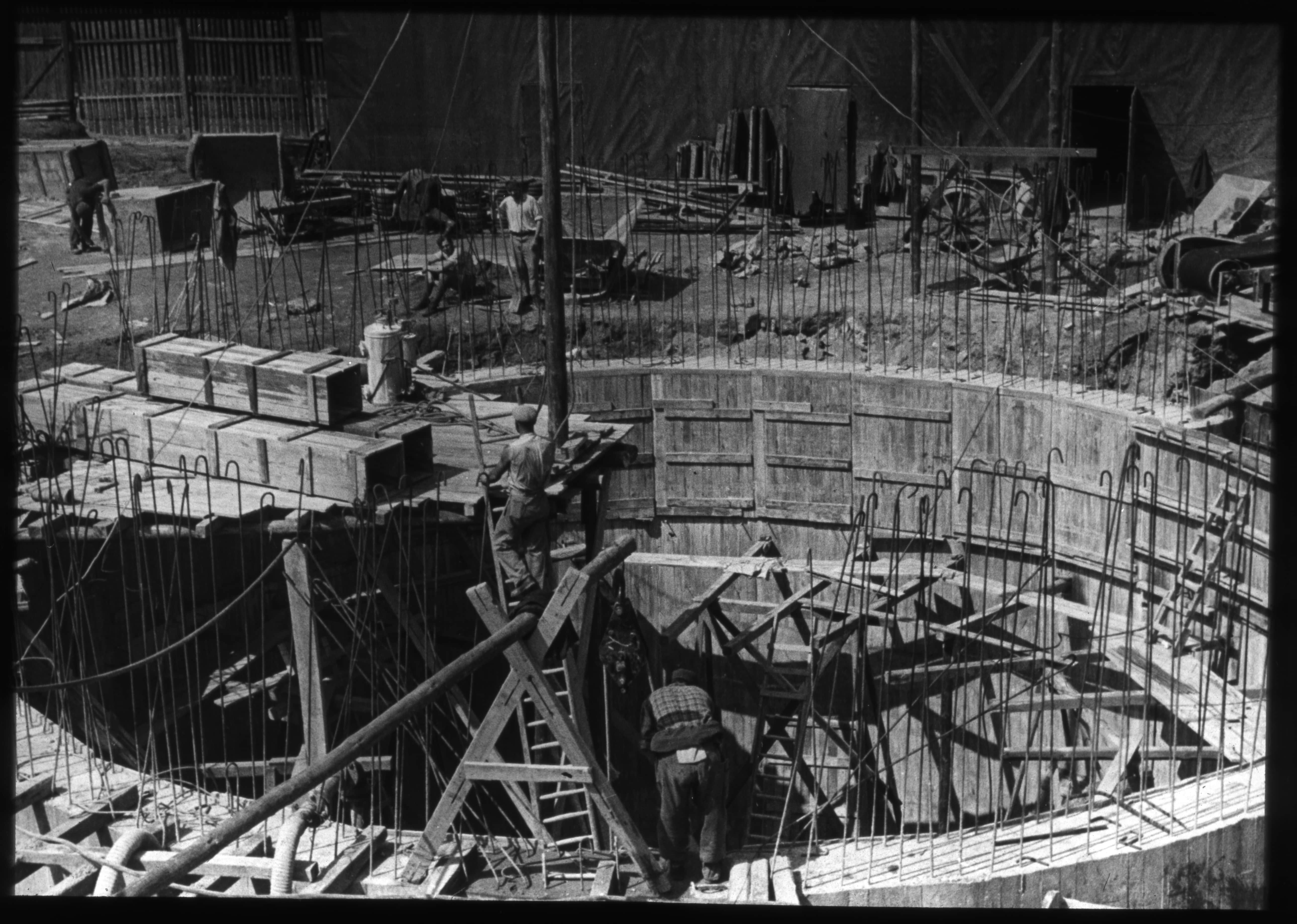
Design Statement:
The public discussion around the “heavy load-bearing cylinder” framed the object as a toxic subject for Germany’s cultural memory due to its origin in the Nazi era—and many voices demand its erasure rather than its preservation. I want to challenge this one-dimensional reading by framing the structure as object that transcends the binary of Germaness/Naziism that drives the public condemnation by reframing it as an ‘inconvenient’ memorial that opens a space of deep insights into what it means to be (in-)human. At the core of my argument is the assumption that culture and barbarity are closely intertwined and cannot be separated. Consider this: the Nazis built “heavy load-bearing cylinder” was built an engineering measure to test how weight Berlin’s soil can take. Based on the data collected at the site, the regime planned to erect a gigantic triumphal arch nearby, an architectural statement that articulated their goal of world domination in an ancient Roman imperial aesthetic. Despite this anti-modern cause, the data collected at the site was highly influential in shaping the norms we still use for building high-rises and other heavy buildings until today. As inconvenient as it is, I have to argue that the structure is as much a monument for Nazi barbarity as it is a monument for German technological expertise. In fact, I do not think we can separate Germaness/Naziism, as inconvenient as it sounds—we need to get to terms with that. This photograph of the gaping hole was taken during the construction of the drum and symbolically stands for the abyss, or “Bodenlosigkeit” (groundlessness) of memory that we have to dive into to grapple with it.
Substantive Caption:
As an urban humanist interested in the intellectual history of the Nazi period, I am grappling with a unique remnant of this time: Albert Speer’s so called heavy load-bearing cylinder; a massive concrete structure outweighing the Statue of Liberty, the Eiffel Tower, and the statue of Jesus Christ in Rio de Janeiro combined. Originally planned as an engineering measure to prepare Berlin’s unpredictable soil for the erection of a gigantic triumphal arch, this fragment of an unfinished project still haunts the collective consciousness. Ill-reputed as “fungus” in the public narrative, voices that demand its erasure summon, while others call for its preservation. During my field- and archival research in Berlin, I collected thousands of visuals spanning from historical photographs and construction plans to post-war art projects. I am interested in exploring ways to structure my visual archive and critically analyze the “toxicity” or “intoxication” of this mute object in the urban memory. The questions is: shall it be erased, as it attracts neo-Nazis who are on the rise in Germany, or, does it have to be preserved for public memory? Can an object be toxic for our memory? How can we express that visually?
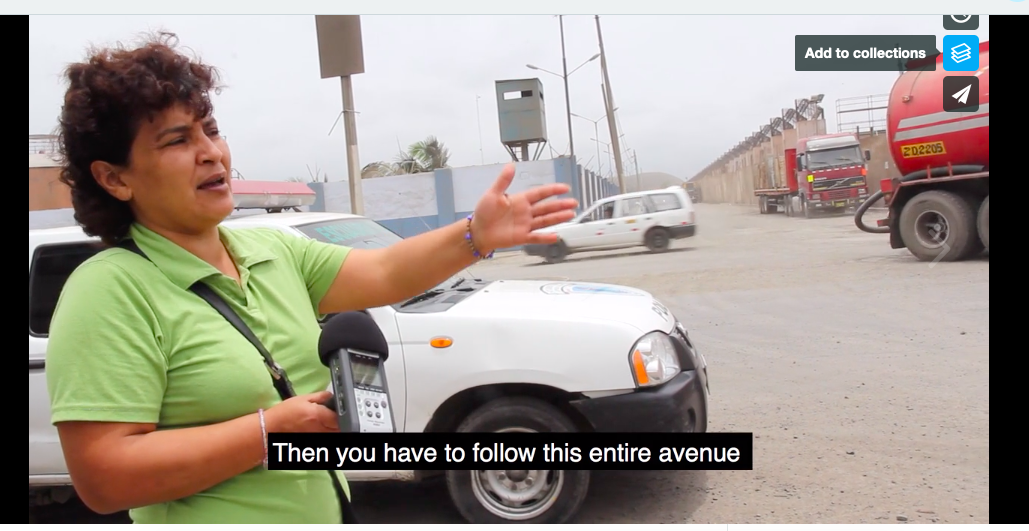
At the Port of El Callao, residents know from previous scientific studies that their urban ecology contains lead from the storage and transport of mineral particulate and so do their bodies. They are also acutely aware that little has been done by the state or mineral brokers to remedy their situation. In daily life, they are left to observe, hypothesize, and imagine the pathways through which lead enters into their neighborhoods, homes, and bodies. This set of images previews a scene of the "Lead Zone" in which a resident maps the movement of lead particulates outside the storage yards–– from soils, tires, air, to lungs.
Design Statement:
I selected this screen shot from the film documentary "The Lead Zone" (Graeter 2018) because it captures a moment of toxic virtuality storytelling.
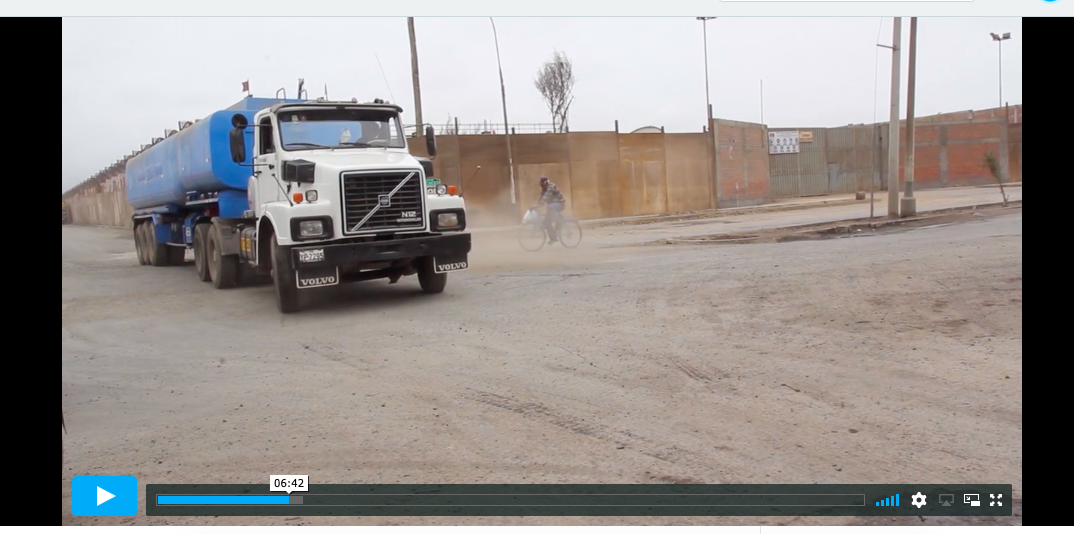
At the Port of El Callao, residents know from previous scientific studies that their urban ecology contains lead from the storage and transport of mineral particulate and so do their bodies. They are also acutely aware that little has been done by the state or mineral brokers to remedy their situation. In daily life, they are left to observe, hypothesize, and imagine the pathways through which lead enters into their neighborhoods, homes, and bodies. This set of images previews a scene of the "Lead Zone" in which a resident maps the movement of lead particulates outside the storage yards–– from soils, tires, air, to lungs.
Design Statement:
I chose this screen shot from the documentary film "The Lead Zone" because it poignantly captures the inevitability of leaded dust inhalation at the Port of El Callao.
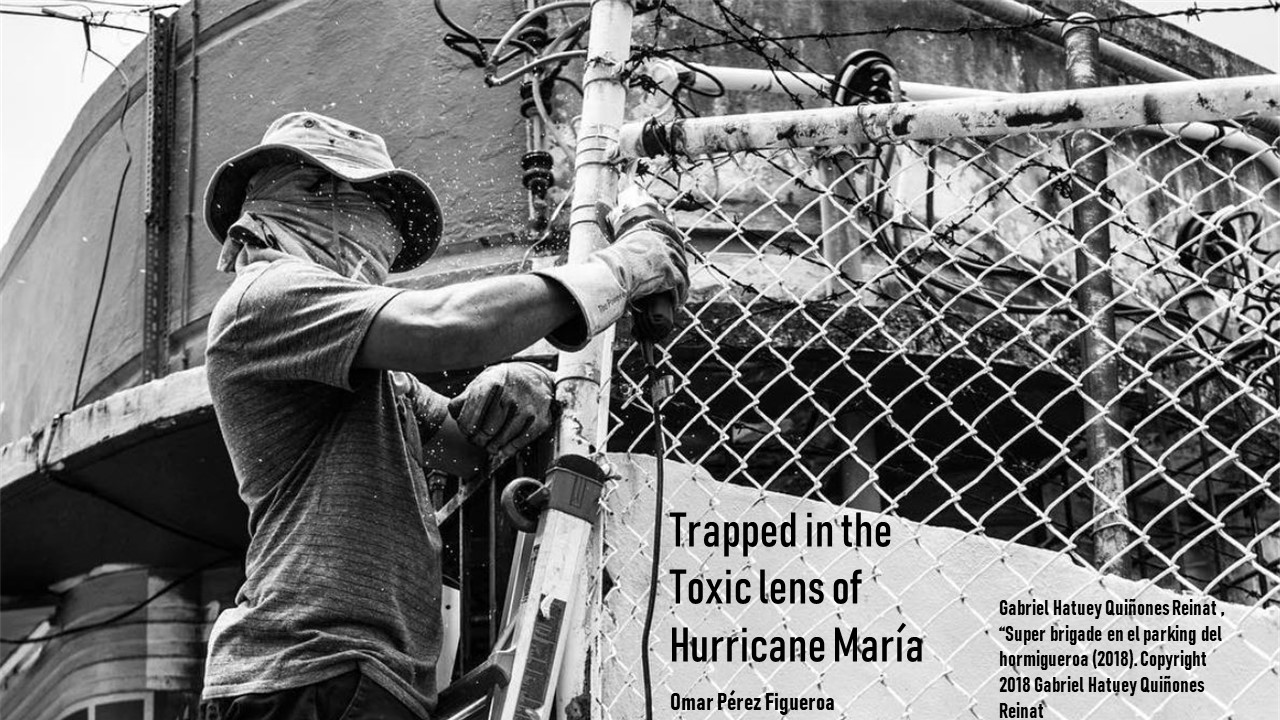
On September 20, 2017 Hurricane Maria struck the island of Puerto Rico. The consequences were disastrous; no water, no electricity and no communication within the island or with the outside world. Although more than a year has passed, people continue to live under precarious conditions.
The hurricane triggered a massive relief response, from governments, NGOs and individuals. However, not all of these responses were conducted equitably. Elements such as power, the political climate, United States Colonialism, Wallstreet interest and a top-bottom approach to disaster management cascaded the disaster into a real mess.
This photo combination explores how these toxic elements created before or after the event shaped the island’s response to Hurricane Maria. While my first photo essay (The Toxicity of the U.S Aid Relief) highlights the intended or unintended consequences of the relief process carried out by the U.S government on the island, this new set of images reflect on how strategies used by Puerto Ricans to resist toxic relief and aid can reproduce toxicity in itself.

Substantive Caption:
(Keywords) religion, relief, white savior complex
While some faith based institutions (both local and foreign) were instrumental in the relief process post Maria, others reinforced the white savior complex through their actions. Many faith based institutions that came to the island after Hurricane Maria were foreign, and their actions responded to their own organization’s objectives and not necessarily to what people needed. Furthermore, these actions can lead to reinstate the system that has maintained communities in a precarious state rather than questioning the structure that keep them oppressed. In a way, this structure this structure imposes people’s forced acceptance of their situation, producing a veil between the perception and reality. For example, the structure of some faith based institutions promotes the idea that event such as hurricanes are simply “natural” disasters and that people must accept their consequences as a natural process rather than question their consequence as a product of human impact.
Design Statement:
In this image, there is status of Jesus next to a newly sprouted plant. I am trying to convey how faith based organizations are embedded in the everyday life of residents. Also, faith based institutions have a lot of political power on the island, which sometimes translates into forcing unjust policies onto citizens. For example, Puerto Rico’s senate wanted to approve the "Religious Freedom Law", which would allow government employees to oppose taking actions that go against their religious beliefs (e.g. it would allow a Demographic Record employee to refuse to make a sex change on a birth certificate if a transsexual requests it).
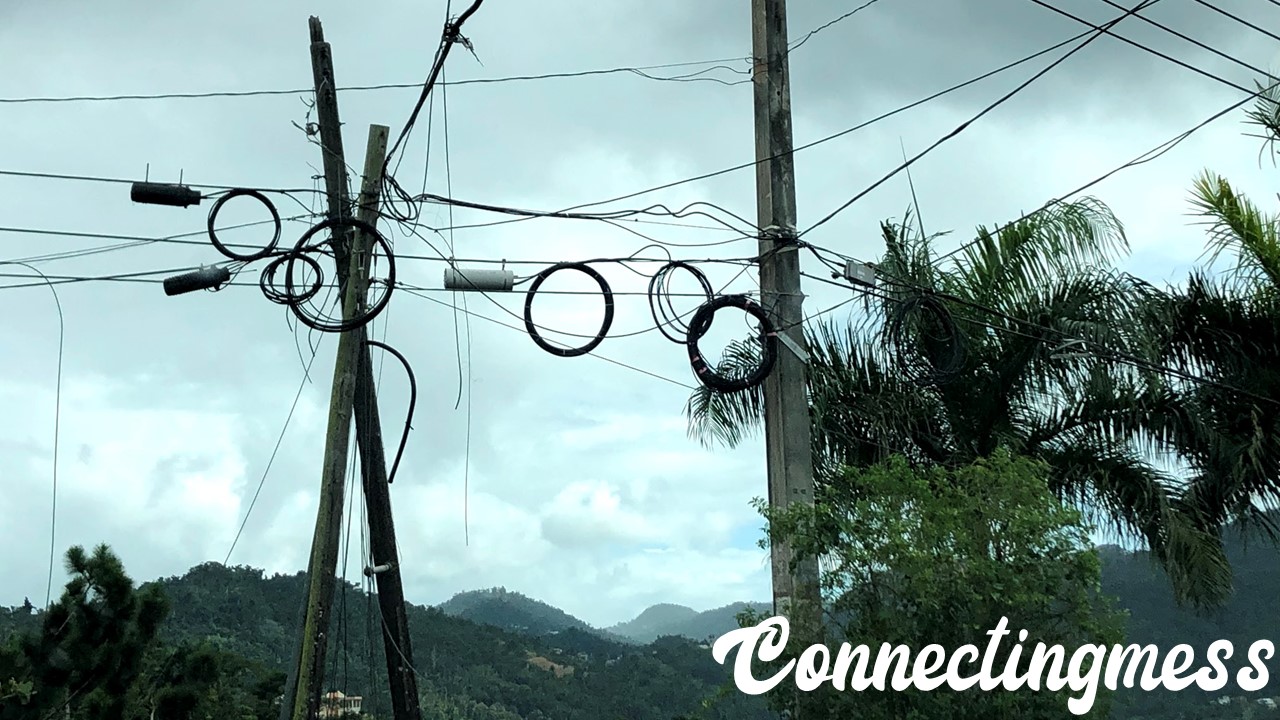
Substantive Caption;
(Keywords) electrical grid, connection, physical visualization of toxicity
Hurricane Maria left the island of Puerto Rico in total blackout. Almost two year has passed after the hurricane and there are still places that have no electricity. No electricity means no food in the fridge, mosquito bites, no school and for some it can mean the difference between life and death. Because state’s response has been so slow in connecting power to citizens, some people decided to connect the power lines back to their houses without the electric authority authorization. Furthermore, these same actions that residents are employing are the same ones that can expose them to toxic outcomes, such as death or physical damages if the person connecting the electricity fails to do so properly.
Design Statement
This picture serves as visual representation of the chaotic political structure and political toxicity on the island. Before Hurricane Maria, the power grid was in bad shape (physically and financially). The financial hole the power authority found themselves in was caused in part to the emission of bonds to pay off Puerto Rico’s debt to hedge funds, mostly from Wall Street. Wallstreet interest unlawfully incentivize Puerto Rico government to issue these bonds even though both parties were aware there was no liquidity behind the bunds, and therefore there was “no” way they could pay them back. Two years later Puerto Rico was forced into bankruptcy. Furthermore, for years the local government wanted to privatize the power grid under the excuse that in needed to be modernize. After the hurricane the government had the perfect excuse to start their privatization plan for the power grid. Without any proper selection mechanism, the local government signed a $300 million contract to hire a company with little to no experience repairing power grids. Furthermore, after the cancelation of the contract the local government continue paying this company for 30 days, because of a clause the government neglected to see.
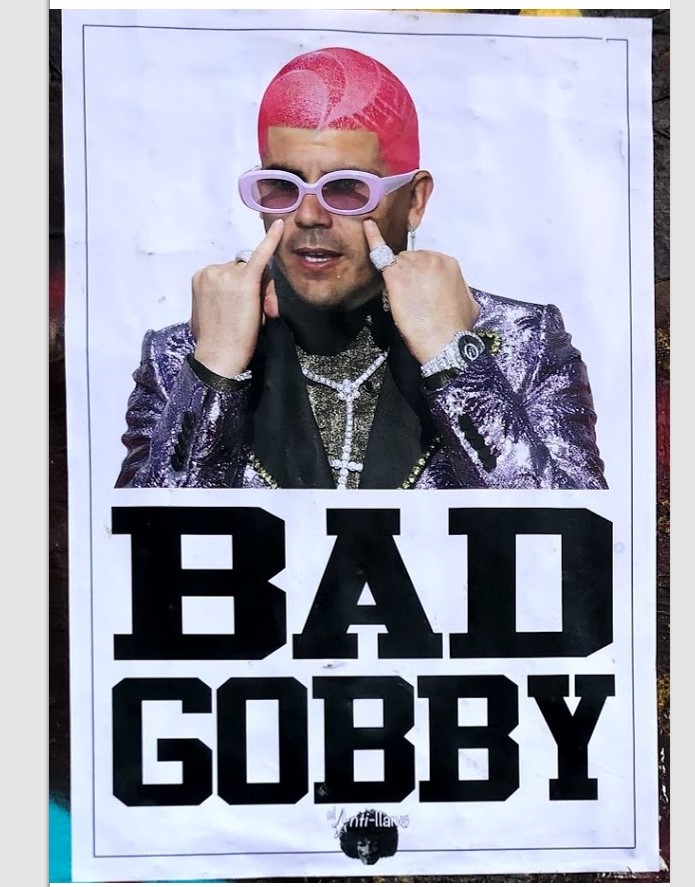
Substantive Caption:
(Keywords) deaths, disaster, government, art
In a sense I am trying to capture how political actions leads to disaster, and how disaster breeds disaster under our current political climate conditions. One of the figures heavily criticized in Puerto Rico is former governor Ricardo Roselló. His government denied that the island went through a health crisis during Hurricane Maria. Although the government stated that only 64 people initially died in consequence of Hurricane Maria, several researchers and journalists have reported the mortality rate beyond 4,000. Furthermore, the local government praised the Federal and Executive branch of the U.S government for their response to the event, overlooking the fact that they were responsible for stopping food and relief supplies at the ports of Puerto Rico the weeks following the hurricane. Puerto Rico's governor has been very lenient on critiquing the U.S government under the wrong impression, that will pave the way and draw political support for Puerto Rico’s statehood.
Design Statement;
Historically in Puerto Rico, art has been used as a way to bring political issues to mainstem society. The original picture is from a street artist called el Anti-llano (circa. 2018-2019), and it shows a Puerto Rican trap artist, Bad Bunny. Through art, it appears as if the artist is juxtaposing and playing with words, writing "Bad Gobby" instead of Bad Bunny. This image conveys how, through art, government figures and actions have been heavily criticized. Furthermore, this piece of art was "hung" into one of the main transit roads in San Juan (Puerto Rico's capital).

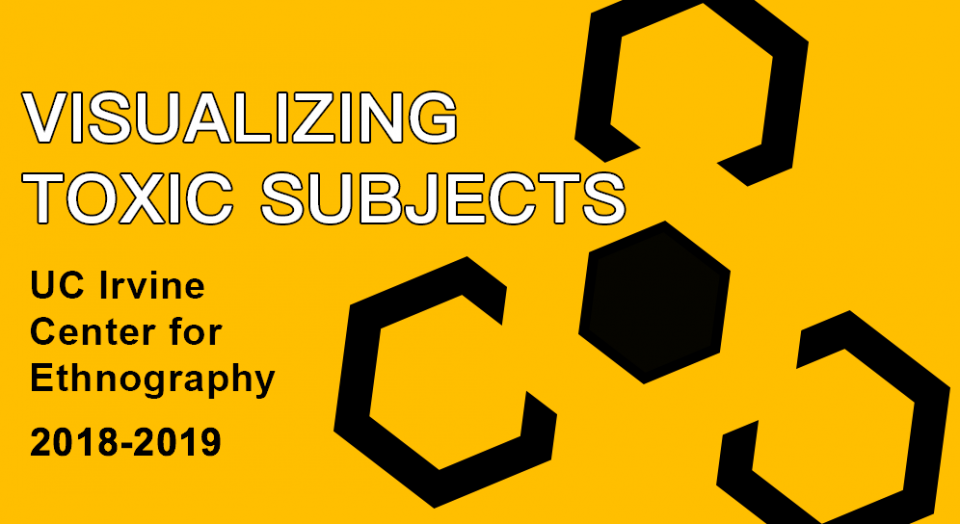
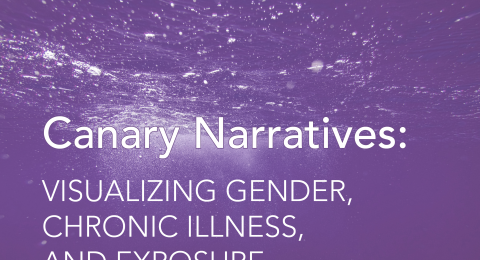
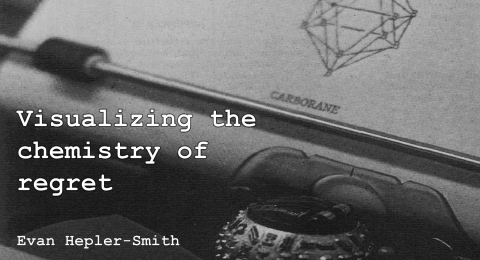
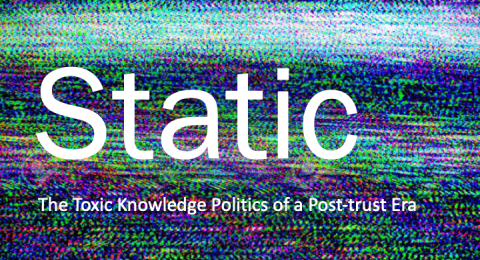
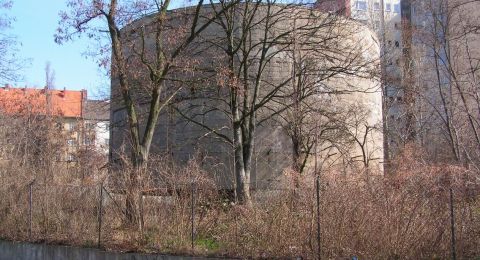
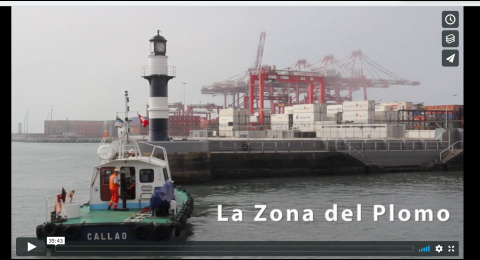

Substantive Caption:
The main image depicts the editorial offices of Chemical Abstracts, circa 1938. For most of the 20th century and through the present-day, the abstract journals, collective indexes, and databases of Chemical Abstracts (now Chemical Abstracts Service, or CAS) have been the authoritative source for bibliographic and regulatory information about chemical substances and the chemical sciences, including allied fields such as toxicology. In this image, “index workers” are engaged in compiling an annual or decennial index of the publication. In the early 20th century, the new specialization of "literature chemistry," demanding considerable chemical expertise, presented professional opportunities seized by chemists belonging to groups marginalized within lab-based chemical occupations--most prominently, women.
The vast majority of these cards refer to individual chemical substances rather than subject headings or author names. Much index labor involved writing, rewriting, cross-referencing, and error-checking the systematic chemical names that were the key to the whole enterprise, since they allowed for the arrangement of hundreds of thousands (today hundreds of millions) of substances in chemically-meaningful alphabetical order. This work was particularly challenging because the research chemists who wrote the journal articles abstracted and indexed in Chemical Abstracts often did not themselves use systematic names. This was both because the names were cumbersome and because the uniform chemical ontology that they expressed was sometimes a poor fit for how chemists defined the substances that their research addressed. Sustaining the molecular ontology of chemistry and chemists' access to information was crucial, challenging work.
“Among personal characteristics for this type of work accuracy perhaps should rank highest, and with that conscientiousness, patience, a meticulous attentiveness to detail (without a loss of perspective of relative values, since a great deal of work has to be turned out, at times under considerable pressure), power of concentration, good judgment, and interest in words as words, a love of puzzles and of guessing and digging out elusive ideas, meanings, words, and formulas. An interest in things rather than people is likely to lead to greater satisfaction in this type of work, since the opportunities for personal professional contacts outside the office are relatively few. The analytical rather than the creative type is probably best suited to this kind of work. Good eyes (at least strong ones) are absolutely essential, while the ability to sit hour after hour without much relief is a requirement not to be laughed off. Work of this nature is not for the overly energetic or restless person” (Scott 1938, 275; italics in original).
The inset image depicts a form of the sort that was used when CAS re-created this whole operation on digital computers during the 1960s.
Molecular identity is not given by nature. Rather, it was made in meeting rooms and editorial offices, for the purposes of organizing information about chemical substances, in order to support research and development within the turn of the century synthetic chemicals industry (Hepler-Smith 2015a; Hepler-Smith 2015b; Hepler-Smith 2016). And both making and maintaining this system of molecular identity took (and takes) a whole lot of *work*.
My intention in juxtaposing these images is to direct historical and ethnographic attention to the situated practices—including especially bureaucratic practices—through which the simplicities, complexities, and uncertainties of environmental toxicity are constituted. They are typically taken to be baked into the material nature of chemical substances and bodies. To a certain degree, they are; but they are also the product of a way of ordering the world of substances that I am calling “molecular bureaucracy” (Hepler-Smith 2019). The institutions, practices and technologies that render the world molecular (cf. Myers 2015) entail simplifications, frustrations, fortuitous affordances, and regrettable consequences. Training our vision on easily-overlooked legal definitions, information technologies, administrative procedures, clerical labor, and nomenclature conventions can help shed light on why toxic subjects get visualized in the ways they do.
Design Statement:
This is a pairing of two images, one copied from a chemical journal article published in 1938, one a photograph of manuscript material from an archive.
The main image and the article from which it is drawn, written by an editor at the publication Chemical Abstracts, describe the enormous labor of keeping this foundational, taken-for-granted information resource up to date. It is an exercise in infrastructural inversion (Star and Bowker 1999) avant la lettre. The inset image, the author’s photograph of a manuscript page produced circa 1960, depicts a notation designed by an information entrepreneur to enable the application of mechanical and digital tools to the sort of work illustrated in the main images.
The main image anchors databases and the mechanical objectivity that they embody (Porter 1995, Daston and Galison 2007) in the material and social world of information labor. The inset image exemplifies an effort to shift the social location of judgment and expertise from people intimately engaged with a specific database to machine- and algorithm-makers. Ethnographers and historians can and should ask what knowledge and what social relations, embodied in both people and artifacts, lie behind their databases and visualization methods. Sometimes, the answer may be relatively epistemologically and ethically insignificant vis-à-vis the story at issue; other times, the answer may be the story (e.g. Radin 2017).
References:
Bowker, Geoffrey C., and Susan Leigh Star. 1999. Sorting Things Out: Classification and Its Consequences. Cambridge, MA: MIT Press.
Daston, Lorraine and Peter Galison. 2007. Objectivity. New York: Zone Books.
Hepler-Smith, Evan. 2015. "'Just as the Structural Formula Does': Names, Diagrams, and the Structure of Organic Chemistry at the 1892 Geneva Nomenclature Congress." Ambix 62 (1): 1-28. doi: 10.1179/1745823414Y.0000000006.
Hepler-Smith, Evan. 2015b. “Systematic Flexibility and the History of the IUPAC Nomenclature of Organic Chemistry.” Chemistry International 37 (2): 10-14. doi: 10.1515/ci-2015-0232.
Hepler-Smith, Evan. 2016. “Changing Names and Naming Change: Transformations in the ‘International Machinery’ of Chemical Information.” Proceedings of the International Workshop on the History of Chemistry, March 2-4 2015, Tokyo. 68-76. http://kagakushi.org/iwhc2015/proceedings/.
Hepler-Smith, Evan. 2019. "Molecular Bureaucracy: Toxicological Information and Environmental Protection." Environmental History 24 (3). Forthcoming.
Myers, Natasha. 2015. Rendering Life Molecular: Models, Modelers, and Excitable Matter. Durham: Duke University Press.
Porter, Theodore M. 1995. Trust in Numbers: The Pursuit of Objectivity in Science and Public Life. Princeton: Princeton University Press.
Radin, Joanna. 2017. “Digital Natives”: How Medical and Indigenous Histories Matter for Big Data. Osiris 32 (1): 43–64.
Scott, Janet D. 1938. “The Chemist at Work. XIV. My Work with Chemical Abstracts.” Journal of Chemical Education 15 (6): 271–75. doi: 10.1021/ed015p271.
(Revision of May 9, 2019)